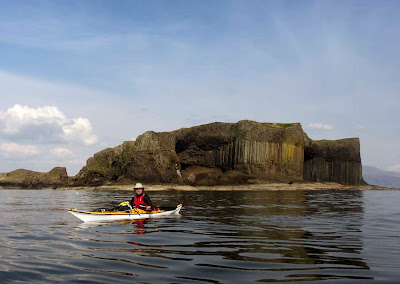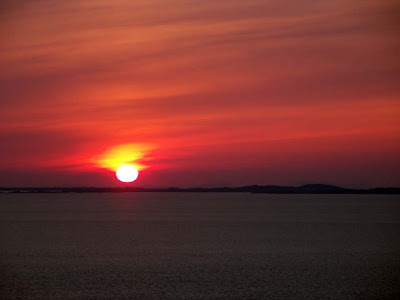
A version of this test first appeared in the December 2006 issue of UK
Paddles magazine.

I first saw the new
P&H Quest LV at the Birmingham show in March 2006. Under the spotlights it looked fantastic and being a fan of the original Quest, I knew I had to try it!
Three months later Mike Thomson from Scottish Paddler supplies delivered his brand new demo Quest LV. The test was carried out over a 10 day unsupported trip to the Outer Hebrides and 20 days of day paddling on the West and Solway coasts of Scotland. The Quest LV was used by 12 paddlers with a wide range of weights and abilities. The conditions encompassed the full range expected when paddling in tidal waters in winds from flat calm up to force 6. The Quest LV was paddled alongside and compared with P&H Quests, Rockpool Alaw Bachs,
Valley Nordkapp LV’s, Valley Aquanauts, a Valley Nordkapp, a Valley Nordkapp RM, a Valley Skerray and a Point 65 XP.
For those of you who have an impatient nature and seek the bottom line, I will save you the effort of looking further down the page. I absolutely love this boat and I know that it will appeal to a very broad range of sea kayakers.
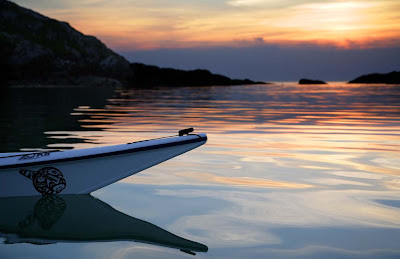
Lewis west coast.
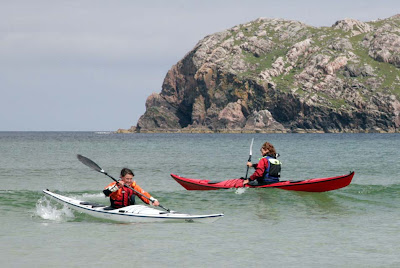
Lewis west coast

Well loaded off Berneray
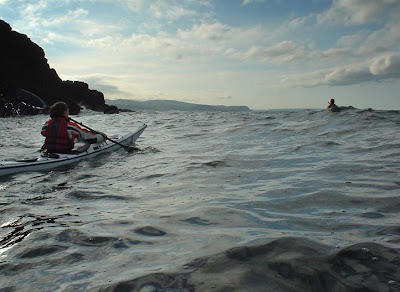
Rounding Bennane Head in the Firth of Clyde.

Solway rock arch.
Design
As you take in the fine lines of this new boat the first thing that strikes the eye is that it is much closer in size to its parent Quest than the Nordkapp LV is to the Nordkapp. Despite being stripped by only a centimetre or two here and there, it looked so much sleeker (I must try this myself!) than the Quest. Ignoring the figures in the brochure, I got the measuring tape out. The length and breadth of the two boats are exactly the same! With the boats sitting on a level surface the bows of the Quest and Quest LV were the same height above ground as were their sterns. Since the seam line has been lowered, this suggests the rocker line of either the deck or the keel has been increased. The cockpit has been dropped by 2 cm. The cockpit length and width in both boats is the same.

The Quest LV beside a Nordkapp LV. Despite the same LV designation, these are not comparable boats, the Quest LV is substantially larger.
Construction, finish, fittings and ergonomicsThe finish on this demo boat was absolutely immaculate, Hatch covers were the excellent Kayaksport heavy rubber items fore and aft and the lighter plastic centred one for the day hatch. This is easy to remove and replace while on the water. The round fore hatch is not so easy for loading long items like tents as the oval VCP hatches on the Nordkapp LV but the Quest LV’s huge oval stern hatch gives excellent access. No covers leaked during the test despite some heavy surf and lots of wet sessions. For 2006, the usual P&H security/tow mount, deck fittings and lines have been augmented by two extra fittings with elastics to tension the end toggles. There are now roughened moulded areas on the deck, just behind the cockpit, which prevent your hands slipping on a wet surface when getting in and out. The demo boat was supplied with a keel strip, which had been very neatly finished. The skeg is controlled by a sliding cable. Unlike the Valley system, it is not supported by a stainless steel sleeve where the cable is exposed at the deck slider. The skeg on the demo Quest LV worked faultlessly but two of the 2005 Quests had evidence of kinked cables at the slider.

Kayaksport plastic centred day hatch.

Silva compass deck recess makes an ideal pilot whale vertebra holder.

Tensioned end toggles.

Skeg cable slider lacks the reinforcing stainless steel sleeve round the cable as found on the Valley Nordkapp LV.
The Quest LV bulkheads were shaped from flat sheets of GRP and bonded to the hull at right angles with glass mat. (In comparison, the 2006 Valley bulkheads are made from a shaped piece of GRP, which has dished edges and is pushed into the narrowing hull before being bonded in place. The idea of this is to spread the load on the hull and prevent cracking of the gel coat.) One of the 2004 Quests did have some minor gel coat cracking under the bulkheads, as did two of the 2005 Alaw Bachs. The Rockpool website says they “plan to develop dished bulkheads in future”. One of the 2006 Nordkapp LVs was leaking at its dished bulkhead. (Personal experience of both Valley and P&H warranty support for leaks has been excellent.) The Quest LV’s traditional bulkheads remained watertight.
The cockpit had plenty clearance between its lip and the deck to allow easy fitting of heavy-duty neoprene spray decks. In comparison, the Rockpool Alaw Bach had little clearance and it made fitting some decks very fiddly. The Quest LV cockpit was not quite so easy to get in and out of as the Nordkapp LV, which was 5 cm longer and 2.5cm lower. The Yakima footrests are mounted on alloy tracks. These worked well when clean but after a surf session with several wet exits, both tracks became jammed with sand. The relationship between the lowered underside of the cockpit with its moulded knee/thigh braces is very comfortable for a wide range of paddler sizes. The security given by the Quest LV braces is midway between the very secure but aggressively curved Rockpool braces and that of the Nordkapp LV cockpit which lacks moulded braces.
The Quest LV came with the padded plastic seat with ratchet belt adjustable back band. There is an (no cost) alternative GRP seat. The first thing to note about the padded seat is that it is extremely comfortable for 99% of the time. However, if you are the type of sea kayaker that likes to practice wet re-entries, you will become frustrated as the seat back folds forward under your bum as you re-enter the boat. The second thing to note is that the seat fitted high in the boat. In comparison, the Rockpool seat could not have been fitted any lower and I am sure that the resulting low centre of gravity contributes to that boat’s outstanding stability in rough conditions. At first we did not notice any adverse effect of the high seat position, but we were laden with gear and provisions for a 10 day unsupported trip. Once the boat was unloaded, it felt less stable and for the remainder of the Hebridean trip it was paddled with rocks to load it on day paddles.
This is not a problem unique to the Quest LV. Two of the Quests had high mounted plastic seats and two had low mounted GRP seats. Swapping these boats between us showed that when unloaded all owners felt more stable with the low seats. All three Nordkapp LV owners had also found their plastic seats to be mounted too high. All had removed the thick pad and refitted their seats as low as possible. On return from the Hebrides, The Quest LV seat was lowered (with Mike Thomson’s permission) and the seat back secured with some ties to the rear cockpit bulkhead. What a transformation! The boat felt much more secure and stable in a wide variety of conditions. One paddler who tried the boat before and after, is saving for a Quest LV with the low GRP seat and Mike Thomson was so impressed by the transformation that he ordered a second demo boat with the optional GRP seat.
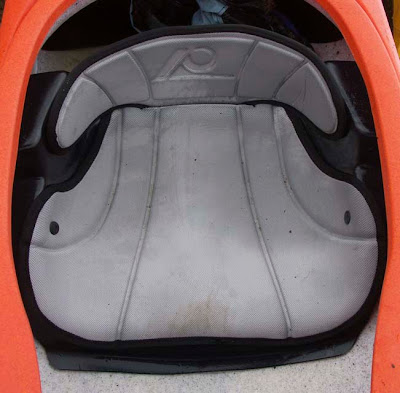
The seat supplied with the demo Quest was the same as this one fitted to a poly Capella. We removed it and fitted a smaller plastic seat from a Nordkapp LV. Muzz from
Highland Mist has posted two excellent articles on lowering the same seat in a P&H Sirius
here and
here.
There are two final comments about the Quest LV seat. The ratchet buckle started to rust on day five. The Quest LV seat is the same width as the Quest seat, so slimmer paddlers must be prepared to pad it out with hip pads to give proper control of the boat.

Corrosioin on the back band buckle.
Performance.
This is possibly one of the most versatile sea kayaks on the market. From its measurements, I was not expecting much difference in performance from its parent Quest. How wrong I was. This boat is so more manoeuvrable than the Quest. Its turning response to edging is completely different. Once on edge it can be held over much more easily and stably than the Quest. Even a 65kg tester had no difficulty edging the Quest LV. She felt swamped in a Quest. The Quest LV is not as manoeuvrable as the Alaw Bach or the Nordkapp LV but it is not far behind and it even feels as manoeuvrable as the superb Aquanaut which until now has been one of the most manoeuvrable of full size expedition boats. Unlike the Quest, the Quest LV is very responsive to steering in confined spaces using bow rudder strokes.

Although the Quest LV has gained manoeuvrability it has not lost any speed. It achieves the same sprint speed as the Quest: On the one windless day at slack water, the following boats’ maximum sprint speeds were measured using a Garmin GPSmap76cs (with WAAS/EGNOS enabled giving 2m accuracy: Quest LV: 10.6km/hr, Quest: 10.6km/hr, Nordkapp RM 9.9km/hr, Nordkapp LV: 11.5km/hr, Alaw Bach: 10.1km/hr. Unladen, the Quest LV accelerates well but not so easily as the Nordkapp LV. It rolls very easily and as long as the seat back is secured, it is very easy to re-enter and re-enter roll. With the low seat position it makes a stable platform for photography, using binoculars and fishing. It is a good boat to use for towing rescues. It also makes an exceptionally stable platform from which to rescue others, even in rough water.
I have always liked paddling the Quest off the wind with a following sea, fortunately the Quest LV has lost nothing in this respect and I think the chines at the stern help to pick up waves. It does not surf so easily as the exceptional Alaw Bach but it revels in long open windy crossings when the Alaw Bach will require more skill and effort to keep it on track. It remains very controllable as the swell approaches the shore and ramps up into surf. I think it is a bit easier to keep on line and resist broaching than the Quest. Once broached and you are bracing off the wave, it gives a very stable ride into the shore. The Aquanaut, the Nordkapp and especially the Nordkapp LV are easier to keep from broaching. On flatter water there can be few boats that trim to the skeg in a wind so well as the Quest LV and give such relaxed and balanced paddling downwind.
Going upwind in the Quest (about 45 degrees to the wind), I have always been annoyed by the way certain waves splash up over the deck about level with the foot pegs and blow back right into my face. Despite the apparent similarity in hull shape, I did not notice this with the Quest LV! Paddling into short steep waves exposes significant differences in the way current sea kayaks behave. The Point 65 XP (when unloaded) seems to keep on the most even of keels. Bigger Valley boats seem to throw their bows high over the wave. The Quest seems to nod its head into the wave, taking water over the bow. The water washes off well before the cockpit and the Quest does seem easier than the Valley boats to hold its speed in these conditions. Given its lower volume, I expected the Quest LV to be wetter than the Quest in these conditions but again I was wrong. It behaved in a way midway between the Point 65 XP and the Quest.
On expeditions the Quest LV can take substantially more gear than the Nordkapp LV. This was very apparent on our 10 day trip as one Nordkapp LV paddler; known for her minimal approach to packing, was saying she missed the space in her previous Nordkapp Jubilee. Even when the Quest LV is fully loaded with gear, heavy weight paddlers of 90kg or so floated with freeboard to spare.
Dimensions.
As measured rather than quoted: Length 536cm, breadth 55cm, cockpit 73cm x 42.5cm, height of cockpit front 33.5cm, weight standard construction with keel strip 25.5kg.

Hull plan shapes.
Conclusion.On first appearance, the Quest LV is only a subtle development of the Quest. Only on the water does the true scale of its leap forward in terms of performance and versatility become apparent. Development and fine tuning of an existing design has paid off for P&H. This is a boat that has something to offer beginners and advanced paddlers, heavy and light paddlers, day trippers, weekenders and hardened expeditioners. It is fast, manoeuvrable, forgiving, comfortable and well built. Only the heaviest and largest of paddlers should consider the Quest before it. It is possibly the best all round boat on the market. I recommend you add it to your demo list.
Yes, if you want a playboat for the sea, go for a Rockpool Alaw/Bach. Yes, if you want a fast, responsive tourer for shorter trips, go for the Valley Nordkapp LV. But for a huge group of sea kayakers, who want one boat to do it all, the P&H Quest LV is the boat they should try. 2006 has proved a vintage year for new UK sea kayaks. Like the Nordkapp LV before it, I award the P&H Quest (with the GRPseat) 12/10!




